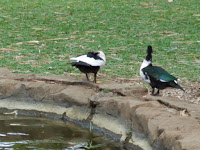Click on pictures to enlarge
The first thing
that came to my mind was:
“What’s the
difference between a ‘Rainforest’ and a ‘Jungle’?
My past experience is a temperate rainforest (on Vancouver
Island , BC) and
to my knowledge, I had never been in a jungle.
-
The first resource told me that the 'Jungle is dense, impassable and usually a
tropical forest while a Rainforest is a forest with high rainfall.' The biggest contrast is the amount of
sunlight that peeks through the treetops.
- "Rainforest"
is a technical term in ecology, referring to a particular kind of biome or
climate. "Jungle" is not, and so its definition is determined in part
by how people use it. "Jungle" is a word the
specifically refers to land overgrown with dense, tangled vegetation.
-
Over a quarter of
natural medicines and around 40% to 75% of all biotic species have been found
in Tropical Rainforests (often called the "jewels of the Earth" and
the "world's largest pharmacy").
Trees that heal:
tourist tree
Cacao
Geonoma epetiolata:
called “naked Indian” or “tourist tree”. It is used in different ways to lower
fevers. To treat kidney diseases it is suggested that you cook the leaves and take them in the morning and at night.
Vines:
In Costa Rica
Palms
Palm oil – not to be confused with coconut oil –
is the world’s most consumed vegetable oil and accounts for 33% of
vegetable oil and 45% of edible oil worldwide, according to the Scientific
Journal Nature.
Palm Oil
production has been one of the largest agricultural industries in Costa Rica
Dave’s Natural Pavilion (as noted before in
the Costa
Rica
Growing
houseplants for export has become a booming industry in Costa Rica
 |
| Philodendron |








































































